Hanging baskets are a great way to add life and beauty to any room, whether it be in your house or work space. However, those areas will often not have a huge amount of access to natural light or the light will not be as much as some plants require, meaning you’ll really need to focus on adding low light hanging plants to these spaces.
This is exactly why my picks for the best indoor hanging plants for low light tell you everything you need to know to get the most out of your choice. Not only do these plants look amazing, but you’ll absolutely find something that works for the space you have in mind!
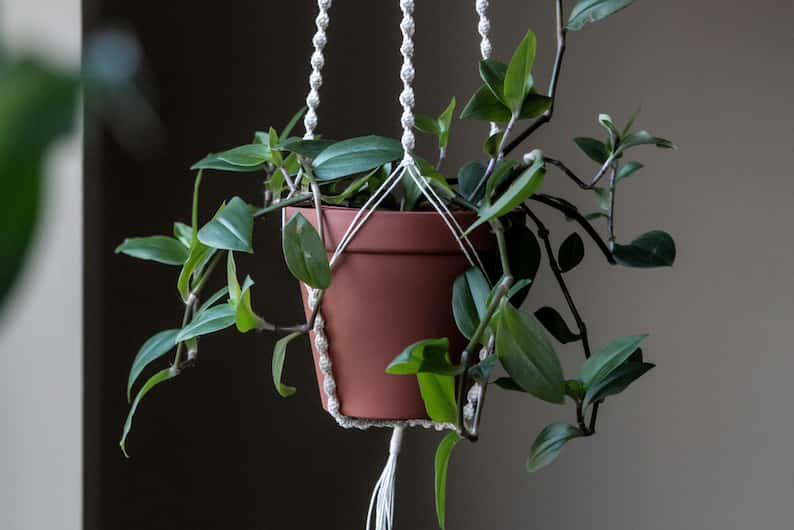
Table of Contents
Best low light hanging plants
We’ve included ivys, ferns, evergreens, and some of the most interesting and time-tested selections for low light conditions. As you’ll see, this list of the best hanging plants for indoors will grow well in pots and baskets and can be incorporated beautifully into any room.
1. Prayer Plant

The Prayer Plant (Maranta leuconeura) has green variegated broadleaves with white veins and a grayish-green or purple underside. It is a perennial that grows to 12-15 inches in height and 12-15 inches in width. The prayer plant may have tiny, almost unnoticeable flowers that can range from pink, white, or purple in color.
It’s not always known as one of the best indoor hanging plants for low light, as many choose to keep it on a desk or side table, but it really looks stunning up in the air too. The Prayer Plant grows in partial or dappled shade and is tolerant of humidity. It will need good drainage if it is placed in pots like hanging baskets. If you’d like to propagate it, you’ll need stem or root cuttings, division, or offsets.
2. Bird’s Nest Fern

The Bird’s Nest Fern (Asplenium nidus ‘Ruffled’) has evergreen green colored leaves with a rippled, or ‘ruffled’, edging. It is a perennial that will grow to 12-18 inches in height and 12-18 inches in width.
This lovely fern grows in partial, dappled, or full shade conditions and is tolerant of humidity. It will need excellent drainage in containers or hanging baskets. If you’d like to propagate it, you’ll need to use spores.
3. Rat Tail Cactus

The Rat Tail Cactus has green stick-like foliage and bright pink flowers. It is a perennial in the cactus/succulent family that grows 12 inches in height and 18 inches in width.
This gorgeous plant – much more captivating than its name perhaps suggests – is good in partial to dappled shade conditions and is tolerant of both drought and humidity. It requires excellent soil drainage when in pots and baskets. If you’d like to propagate it, you’ll need stem cuttings.
Related: 31 Best Low Light Succulents (For Your Home or Office)
4. Rattlesnake Plant

The Rattlesnake Plant (Goeppertia lancifolia) has variegated evergreen foliage in green and yellow colors. It is a perennial that grows 18-30 inches in height and 24-36 inches in width. There are tiny white flowers that bloom on occasion.
It’s also fine as a low light plant, with the Rattlesnake Plant doing well in partial or dappled shade and is tolerant of humidity. It requires excellent drainage to be in pots and baskets. If you’d like to propagate it, you’ll need division of the rhizomes.
5. Nerve Plant

The Nerve Plant (Fittonia albivenis ‘Pink Angel’) has veined evergreen foliage with tiny white flowers. It is a perennial that grows 6 inches in height and 6-12 inches in width.
I love this little guy and I think you will too, especially if you’re on the lookout for some new hanging plants that don’t need sun, as the Nerve Plant is good in partial shade or full shade conditions and is tolerant to humidity. It requires good drainage when placed in pots and baskets. If you’d like to propagate it, you’ll need stem cuttings.
6. Staghorn Fern

The Staghorn Fern (Platycerium superbum) has pretty evergreen foliage. It is a perennial that grows 2-3 feet in height and 2-3 feet in width. It is a fern that is a hanging plant that does well in low light.
If you’re looking for low light hanging plants for the bathroom, this could be your choice, as the Staghorn Fern is good in partial shade or dappled shade conditions and likes humidity. It requires good drainage in baskets and pots. If you’d like to propagate it, you’ll need offsets.
7. Creeping Fig

The Creeping Fig (Ficus pumila) is an evergreen vine that will spread. It is a perennial that grows 12-25 feet in a vine form. It will also fruit up hairy pear-like fruits.
The Creeping Fig is good in full sun, partial shade, full shade (yes, this is one of the hanging plants that don’t need sun to survive), and dappled shade conditions and is both drought and humidity tolerant. It requires excellent drainage to be in pots and baskets. If you’d like to propagate it, you’ll need stem cuttings.
8. English Ivy

English Ivy has divided medium or dark green leaves. It is a perennial that will grow in a trailing form of ivy vine.
The English Ivy plant will grow in full sun or partial to dappled shade, although prefers partial to full shade. It’s tolerant of humidity and drought and needs excellent drainage in pots and containers. If you’d like to propagate it, you’ll need stem cuttings.
9. Maidenhair Fern

The Maidenhair Fern (Adiantum mariesii) has green foliage. It is a perennial that grows up to 3 feet in height and 30 inches wide depending on the variety.
The Maidenhair Fern grows in partial, dappled, or full shade, with many considering it one of the best indoor hanging plants for low light because of its flexibility in terms of its light needs. It needs excellent drainage when in pots and baskets. If you’d like to propagate your maidenhair fern, you’ll need spores.
10. Golden Pothos

The Golden Pothos (Epipremnum ‘Golden Queen’) has variegated evergreen leaves. It is a perennial that will grow around six feet as a vine. The leaves are poisonous and should not be around small children and pets.
This is the perfect option if you’re looking for low light hanging plants for the bathroom, as not only does it look great, but it loves humidity. The Golden Pothos plant grows in partial to dappled shade, although is also fine as a plant that can survive without sunlight, at least directly. If you’d like to propagate it, you’ll need stem cuttings.
11. Spider Plant

The Spider Plant (Chlorophytum comosum) has evergreen leaves and beautiful tiny honeysuckle-like white flowers. It is a perennial that grows 12-14 inches in height.
This one is certainly a hanging plant that does well in low light, with the Spider Plant doing well in full sun, partial shade, dabbled shade, or full shade conditions and is tolerant of humidity. It needs excellent drainage when in pots and baskets. If you’d like to propagate it, you’ll need stolons, offsets, runners, or division.
12. Heartleaf Philodendron

The Heartleaf Philodendron (Philodendron hederaceum var. oxycardium) has evergreen leaves. It is a perennial that grows in a several foot long vine form. Care should be taken as this is a calcium oxalate crystal plant that can irritate and harm pets like cats and dogs.
You can see why this has been popular for some time as a low light vine plants (at least for non-pet owners), given the Heartleaf Philodendron looks amazing and is good in partial, dappled, or full shade conditions and is tolerant of humidity. It requires excellent drainage for pots and baskets. If you’d like to propagate it, you’ll need stem cuttings.
13. Snake Plant

The Snake Plant (Sansevieria trifasciata) has evergreen leaves that are unusually colored. It is a perennial that grows to around 2-4 feet In height and varies in width.
You’ll often see this one in bathroom decor pictures and for good reason, as it’s ideal as one of the options for low light hanging plants for the bathroom. The Snake Plant grows in partial, dappled, or full shade and is tolerant of humidity and drought. It requires excellent drainage when used in pots and baskets.
If you’d like to propagate it, you’ll need runners or stolons, division, or leaf cuttings.
14. Arrowhead Plant

The Arrowhead Plant (Syngonium podophyllum) evergreen leaves. It is a perennial that grows 15 feet long as a climbing vine. Care should be taken not to have this plant around pets or small children as there is calcium oxylate crystals that can harm or be toxic.
That is, if you do have some furry members of the family, you may want to look instead for other low light hanging plants that are safe for cats. Otherwise, though, the Arrowhead Plant grows in partial, dappled or full shade and is tolerant of humidity. It needs excellent drainage when in pots and baskets.
If you’d like to propagate it, you’ll need stem cuttings or division.
15. Oyster Plant

The Oyster Plant (Tradescantia spathacea) has green leaves with white and purple. It is a perennial that grows 6-12 inches in height and 12-24 inches in width. Ingesting may cause mouth burning and irritation and the sap can cause contact dermatitis.
This plant is good in full sun, partial shade, dappled shade, or full shade conditions and is tolerant of humidity. It needs excellent drainage in pots and baskets. If you’d like to propagate it, you’ll need stem cuttings or division.
16. Baby Rubber Plant

The Baby Rubber Plant (Peperomia obtusifolia) has green or dappled green evergreen leaves. It is a perennial that will grow 1-3 feet in height and 1-1.5 feet in width.
It’s another good option when it comes to low light hanging plants, as the Baby Rubber Plant grows in partial or dappled shade. If you’d like to propagate it, you will need stem cuttings.
17. Chinese Evergreen

Chinese Evergreen (Aglaonema commutatum) has variegated evergreen leaves in green and white. It is a perennial that will grow 1.5-2 feet in height and 1-1.5 feet in width. These plants contain calcium oxalate crystals and should not be around pets or small children that may put the plant in their mouths.
As a hanging plant that does well in low light, the Chinese Evergreen grows in partial or dappled shade and is tolerant of humidity. It requires excellent drainage in pots and baskets. If you’d like to propagate it, you’ll need stem cuttings.
18. Cast Iron Plant

The Cast Iron Plant (Aspidistra elatior) has evergreen leaves. It is a perennial that grows to 2-3 feet in height and 1-3 feet in width.
The Cast Iron Plant grows in partial to full shade, so can be a good choice if you need hanging plants that don’t need sun, and is drought tolerant. It is tolerant of most soil conditions when in pots and baskets. If you’d like to propagate it, you’ll need division or offsets.
19. ZZ Plant

The ZZ Plant (Zamioculcas zamifolia) has shiny leather-looking green leaves. It is a perennial that will grow 1-3 feet in height and 1-3 feet in width. This plant is poisonous and it also has calcium oxalate crystals that will burn mouths and so is toxic to cats and dogs.
This plant grows in full sun or partial to dappled shade and can actually more than tolerate low light conditions. In fact, while it does prefer some light, I always recommend it as a perfect low light indoor tree for anyone who needs to decorate a room that doesn’t get much natural light.
It is also tolerant of humidity, drought and poor soil conditions, so it’s good for those who don’t have the greenest of thumbs. If you’d like to propagate it, you’ll need stem, leaf, or tip cuttings or division of the plant.
20. Flamingo Flower

The Flamingo Flower (Anthurium ‘Red King’) has evergreen leaves and showy red flowers. It is a perennial that grows 12-18 inches in height and 10-12 inches in width. Care should be taken as this plant is toxic and has calcium oxalate crystals that can harm cats and dogs.
In terms of its light needs, the Flamingo Flower is good in partial or dappled shade. It requires excellent drainage when in pots and baskets. If you’d like to propagate it, you’ll need division.
21. Rex Begonia
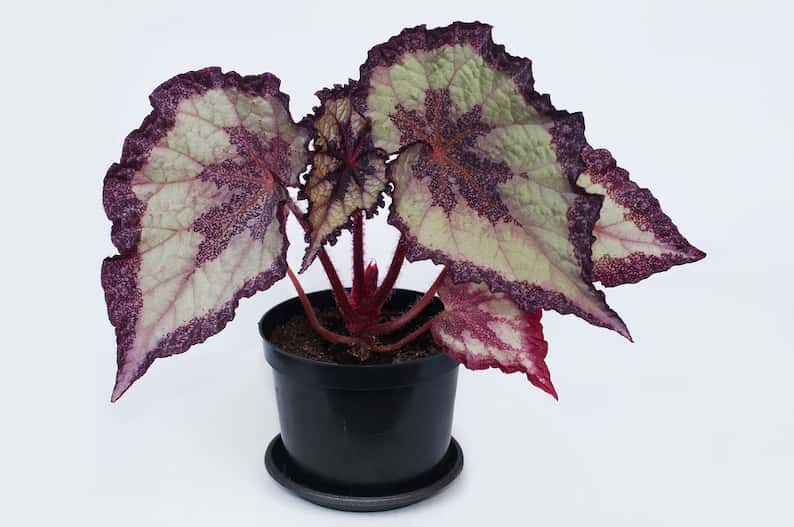
The Rex Begonia (Begonia rex ‘Red Tango’) has green, cream and purple leaves. It is a perennial that grows 12-18 inches in height and 12-18 inches in width. Care must be taken around animals as the plant is toxic, so it doesn’t fit the bill if you’re looking for low light hanging plants that are safe for cats.
This vibrant colored plant is good in partial to full shade conditions. It requires good drainage when in pots and baskets. If you’d like to propagate it, you’ll need leaf cuttings or division.
22. Corn Plant

The Corn Plant (Dracaena fragrans ‘Dorado’) has dark green evergreen leaves that have a chartreuse or yellow edging. It is a perennial that will grow 2-3 feet in height and 1 foot in width. There may be creamy-white flowers that are under an inch that come up in ideal conditions.
This is one of the easier low light hanging plants to care for, with the Corn Plant growing in partial or dappled shade conditions and is humidity and drought tolerant. It requires excellent drainage in posts and baskets. If you’d like to propagate it, you’ll need stem cuttings.
Do hanging plants need a lot of light?
Hanging plants don’t always need a lot of light, as it depends on the plant and its specific light needs. If you put a full sun plant in a hanging basket, it will of course need a lot of light. This is compared to putting a full shade plant in a hanging basket, which will need less light.
As long as your plant is adaptable to be potted and hung up, you can find a proper place for it. For example, low light hanging plants for the bathroom can be hung in corners or above shelving and plants that are full sun flora can be hung directly in a window sill.
There is no end to the choices you can have when doing hanging baskets so do not limit yourself. Just make sure that you have checked how much light the area you want to hang the basket has and adjust your plant choice accordingly – you wouldn’t want to accidentally put your plant somewhere that gets direct sunlight, even for part of the day.
Tips for caring for low light indoor hanging plants
You may think that hanging basket plants do not need specific care than a regular potted plant, but they do! Here are a few tips to help keep your plant thriving.
- Water often – You’ll need to remember that hanging plants have more air flow around them and are higher up toward the ceiling where more dry, hot air is gathered. Plants in hanging baskets have a tendency to dry out more often and need to be watered on a more frequent basis because of this.
- Check hardware – You’ll need to make sure that the hanger that the basket is in and its attachment to the wall or ceiling is secure. There is a lot of weight in moist soil, even if your plant is very light. You’ll want to make sure that there is substantial weight allowance for your plant hangers and how they are attached.
- Fertilize – You’ll want to fertilize your hanging basket plants so that they get good nutrients, especially in low-light conditions. Only fertilize when there is moist soil, as dry soil fertilization will scorch or burn your foliage.
- Dust often – It may seem odd, but a good and thorough dusting of your plant will help make sure that it is getting all the light that it can. Dust can form on the leaves and build up, making photosynthesis a struggle for the plant. By dusting you are helping the plant thrive.
- Get the proper tools – You’re going to want to have a watering jug that has a longer spout so that you can reach to the top of the baskets you’re hanging. There are some great tools on the market designed for hanging baskets so that you don’t have to try to adjust from caring for container plants to caring for hanging baskets.
- Get on a schedule – Set an alarm for a weekly reminder to check on your plant. Check the leaves, the soil, everything for signs of disease or pests. If water pools in your soil, it can be a breeding ground for bacteria and pests, and these are issues that are better to be dealt with earlier rather than later. It’s also a good idea to check that for signs your plants are getting too much light, just to be sure your low light hanging plants aren’t being accidentally over-exposed.
How can I hang plants indoors without drilling?
Don’t want to drill up your walls and ceiling or just want to test a few areas before you make it a more permanent choice? There are so many innovative and creative choices that you have at your disposal for drill-less hanging plant structures. Here are some of our favorite ways to hang plants indoors for display without drilling.
1. Tension rods
The same rods that you may be using to hold up your drapes or shower curtain are perfect to hold up hanging baskets. They easily grip the walls without having to have anything drilled into them, all while displaying your favorite plants.
The best part of tension rods is that they are so easy to remove and place in different parts of the house so you can always change up your look.
2. Clothes rack display
Not just for your clothes anymore, these display pieces can hold your plants too. You can find these in several different styles and some have multiple heights of railing so that you can put them into a very attractive showcase of plants.
Clothes rack displays can come in wood or metal or a variety of builds, so make sure you shop around and find one that blends in perfectly with your decor.
3. S-hook hanging
S-hooks can clip on a hook or rack and are perfect ways to convert something you already have around the house into your very own plant display. Cheap and easy to find, s-hooks will give you an easy and quick way to test your plants in and around the room without having to worry about drilling or other harsh securements.
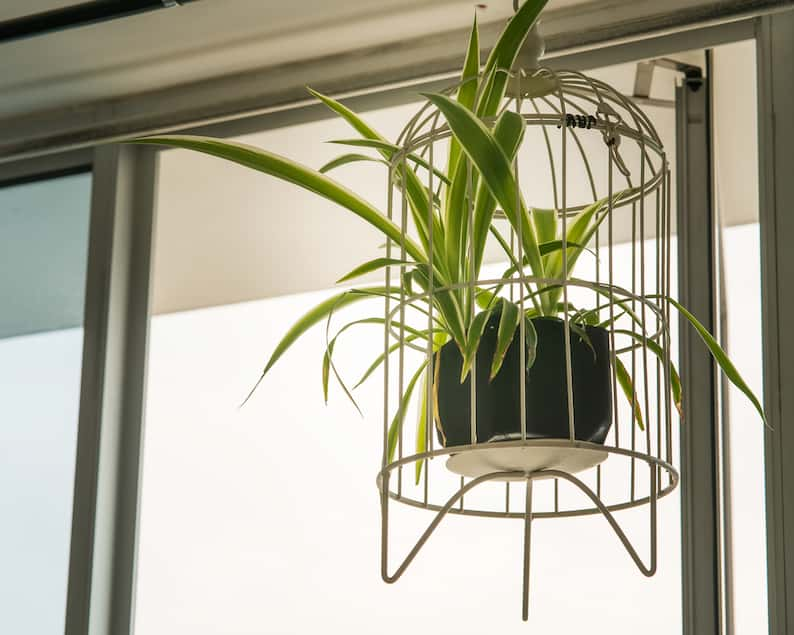
4. Coat/hat rack
These are some of my favorite ways to display hanging baskets in a home or office. A coat or hat rack can be found at thrift stores and yard sales and just a quick touch up of paint can make it perfect for your home’s unique style and décor.
Hang them as you would your hat or coat and watch your friends and family gush over them the next time they come to visit.
5. Macrame shelf holders
Just like the string holders, these macrame holders are designed to hold your plants with care and style. Macrame shelf holders have a shelf that will keep your plants displayed while hanging. Adjust the height in varying lines to really bring a modern trend to your plant display.
6. Macrame string holders
These are the hanging basket experts, and usually always come with a hook already. Take the hook and put it on a rail, rack, S-hook, etc. You can choose from really ornate macrame string holders or minimalistic, and they come in a variety of colors and knot styles.
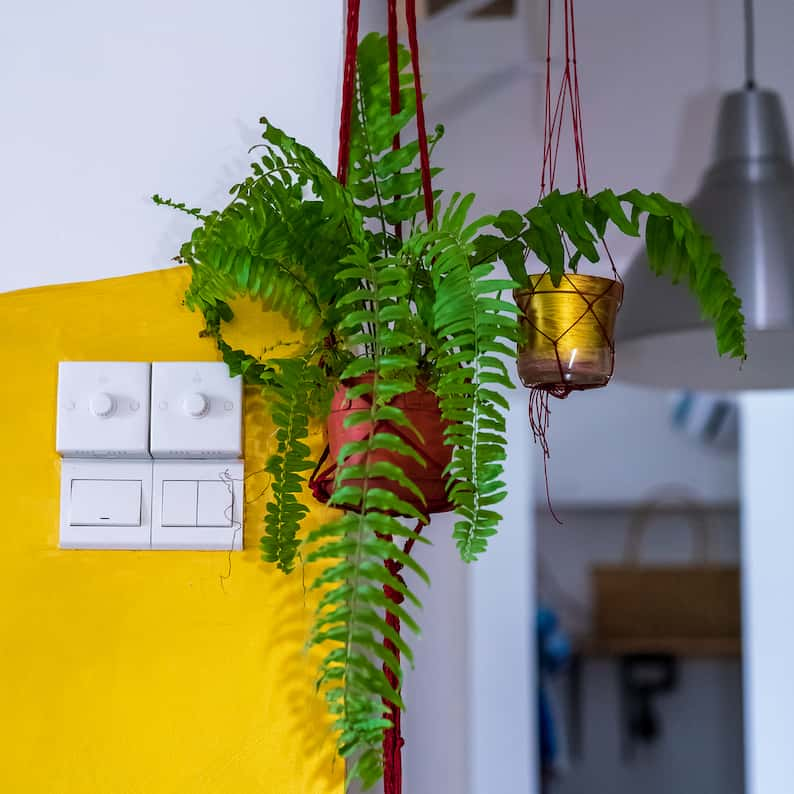
7. Adhesive wall mount plant holders
These lightweight holders come with 3M adhesive tape to mount to the wall. If you have lightweight plants, you can use these to hold the hook of your hanging baskets and have them hang on the wall as an expressive style choice. These can be plastic, wood, or metal holders depending on your taste.
8. Magnetic hooks and holders
In the same vein as the adhesive tape, magnetic hooks and holders can hold your hanging plant on any metal shelving or appliance. Choose a few to hang small plants from the refrigerator or have some coming off a metal shelf.
These are tough magnetic hooks that have specific weight ranges, so check your plants weight against their limits before hanging.
9. Blanket ladder
Do you have a leaning ladder that was for blankets? The best repurposing for an old farmhouse blanket ladder is to hang smaller baskets off the rungs and have it be a quick and dirty plant stand.
These don’t take up hardly any floor space and are a unique way to show off your sense of style.
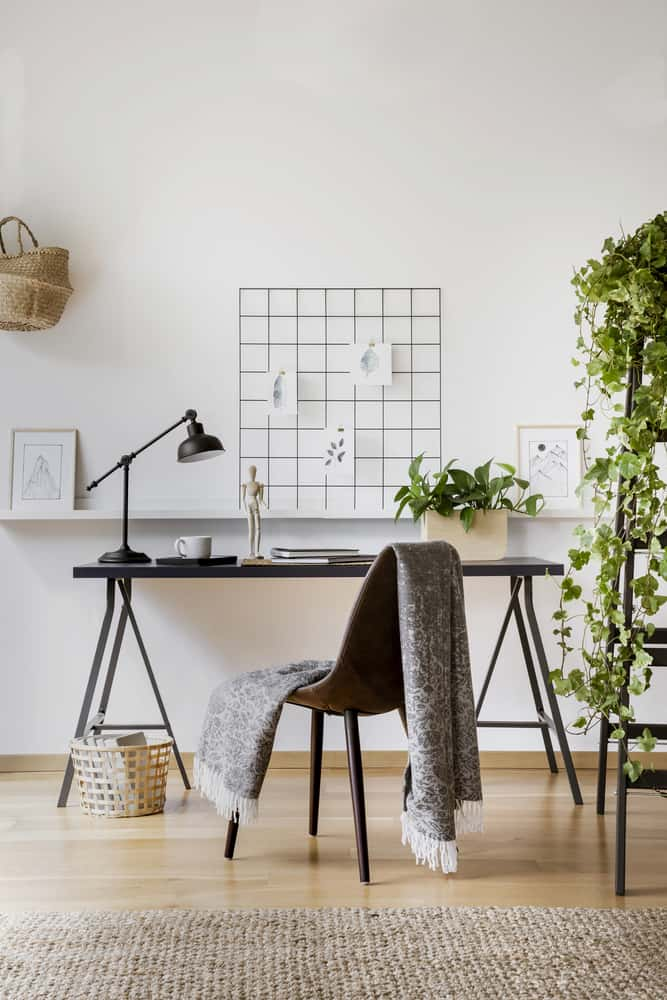
10. Skylight suction hooks
Are you blessed with a skylight? These hooks will hold against the sky light’s glass surface and hang your plants. These are perfect for lighter weight hanging baskets that you want to display in a unique setting.
11. Shelving ladder
In the same vein as the blanket ladder, there are leaning shelving ladders that have shelves in the place of rungs. These are easier if you want to have more versatility on the way you are displaying your low light plants.
12. Over the door hooks
Low light indoor hanging plants look great and are unexpected when you display them on an over the door hook. These turn your door into an entire display center. Most are able to stick straight out, and so they display them perfectly!
These are just the start of the many ways that your imagination and creativity can give you ideas for plant displays. Low light hanging plants and pots can be styled to fit most any home décor setting and can change as the trends change. In today’s plant world, there is nothing holding you back.
What are the benefits of having hanging plants indoors?
Not only is having plants around the home more aesthetically pleasing, there are also many psychological and physical health benefits to having them in the home or office. Here are just a few benefits that you may find when you bring more plant life into your space.
- Fatigue reduction
- Mood boost
- Stress/anxiety relief
- Performance boost
Why? It seems that plants and nature have an almost immediate impact on ourselves in calming our levels of stress and anxiety as well as making us generally in a better mood. There’s a reason why there are so many plants sold in a hospital gift shop!
Through plants there can be a correlation between lowered anxiety and better moods and reductions in fatigue. With these better moods also come better performance in and around the space. Hanging plants that don’t need sun will fulfill these requirements; it’s not just sun loving plants!
